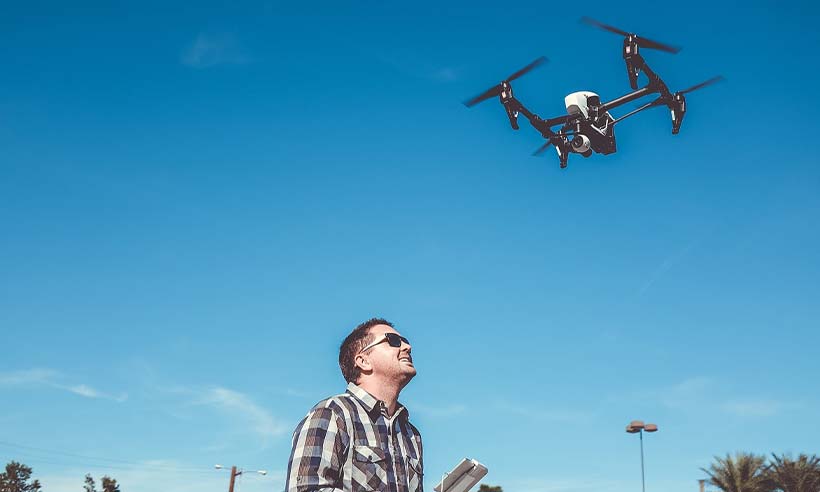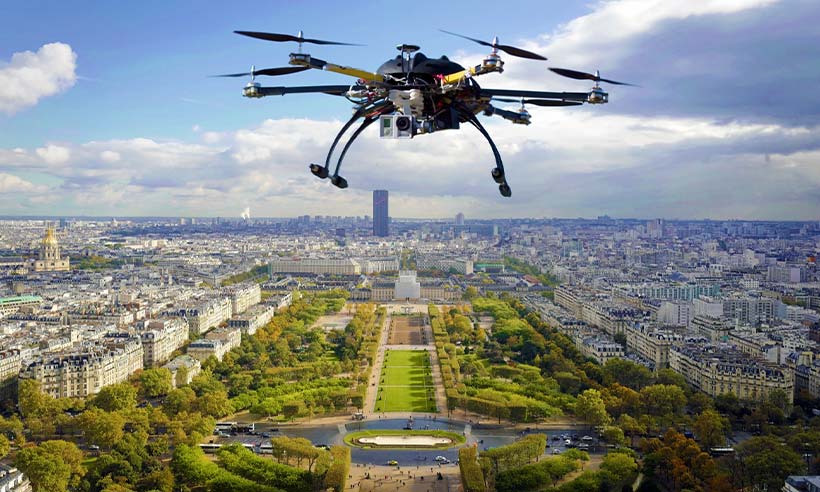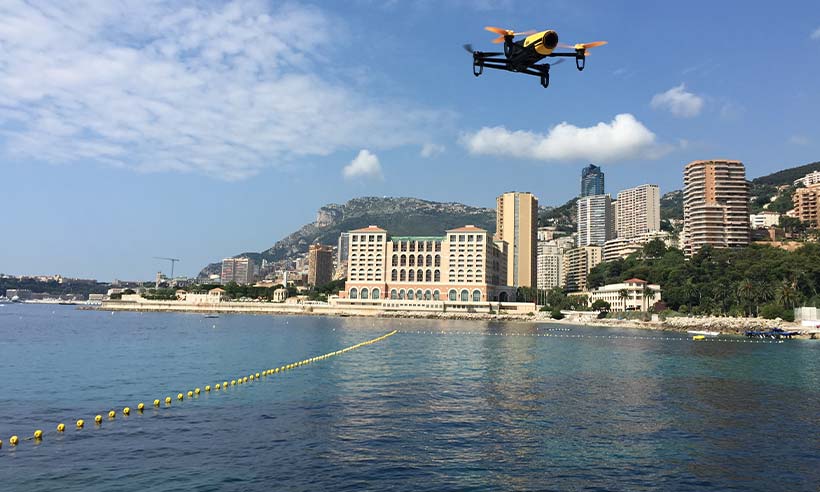Dronelost.com – Drones have become increasingly popular in recent years, both for recreational and commercial purposes. Over time, the technology and capabilities of drones have progressed, allowing them to fly farther and longer than ever before. But just how far can drones fly from the controller?
The answer to this question depends on several factors, including the type of drone, the operating environment, and the controller’s capabilities. We will explore how far drones can fly from their controllers and what you need to know before taking your drone on a long-distance flight.
Before we dive into the details, it’s important to note that the maximum range of a drone can vary widely depending on the model. Some drones are designed specifically for short-range flights, while others can travel much farther. Generally, commercial drones typically have longer flight ranges than hobbyist drones, as they are designed for more advanced operations.
One primary factor determining how far a drone can fly is its battery life. Most drones have a maximum flight time of around 20-30 minutes, although some high-end models can stay airborne for up to an hour. This means that the distance a drone can travel is limited by the distance it can cover within this time frame.
However, battery life is just one factor in the equation. Other important factors include the drone’s signal transmission strength, the operating environment, and the controller’s capabilities. Also, It’s important to consider the maximum drone flight distance. This distance varies depending on the specific drone model, with some consumer drones capable of flying up to several kilometers away from the controller.
How Far Can Drones Fly From Controller?

One of the most important factors to consider when flying a drone is its range from the controller. Understanding a drone’s range is crucial for both pilots and enthusiasts, as it directly influences the types of shots they’ll be able to capture during flight. Drone flight range is determined by several factors, including controller type, drone model, battery life, and obstacles.
The type of controller you use can have a significant impact on the range of the drone. For instance, a controller with a high-frequency range level and channel values can provide a better flight range. While most drones come with a controller that provides a reliable range, some models work better with specialized controllers to achieve longer distances.
For example, certain models of drones are designed to work specifically with smartphone apps that would allow you to control the drone from your phone instead of a physical controller. These apps typically operate using Wi-Fi signals, which can be much weaker and less reliable than actual controllers, especially when obstacles are in the way.
A substantial consideration is the legal restriction and regulations governing drone flying distance. Most countries prohibit flying drones beyond a certain distance, in Absolute limits or relative to the operator. Therefore, checking regional drone laws and regulations is vital before making long-range flights with your drone. The following highlights the approximate achievable ranges for various drone controller types:
- Standard drone controller – 3.5 to 4.3 miles
- Controller with Wi-Fi operation – 1,600 feet to 3.1 miles
- Controller with built-in monitor -2 to 4 miles
- Specialized controller- up to 7 miles
Drones are built with various features such as FPV (first-person view) and GPS systems to enable long-distance flight easily. The range of the drone will differ depending on whether the drone is operated through the app or physical controller, as well as other variables such as the model of the drone and other factors mentioned earlier.
When exploring how far drones can fly from the controller, it’s essential to consider the potential scenario of a lost drone without a tracker. In such cases, utilizing alternative methods becomes crucial for recovery. These methods may involve conducting a thorough search in the vicinity, seeking assistance from local communities or online forums, and using visual cues or landmarks to narrow the search area.
Factors that Affect Drone Flight Distance

For drone enthusiasts, one of the most crucial factors to consider is the maximum flight distance of their drones from the controller. The maximum flight distance can vary depending on several factors, including the type of drone, its battery life, the environment, and many others.
1. Drone Type
The maximum range of drones may depend significantly on the drone’s specifications. The type of drone and the range it can fly is determined by its size, weight, and hardware onboard. Generally, larger and more advanced drones are intended for professional use and have more powerful motors and higher-quality hardware that will allow them to cover more significant distances. Smaller drones are designed for recreational and personal flights and may have a shorter flight range.
2. Battery Life
Another critical factor that affects drone flight distance is battery life. The drone’s battery determines how long it can stay in the air, and thus, it significantly impacts the flight distance. As the battery power depletes, the drone may become unstable and fail, causing it to crash. Therefore, ensuring that the drone’s battery is fully charged before flying is essential. Additionally, keeping an eye on the battery’s life during the flight is crucial. One way to extend the drone’s flight distance is to use a higher-capacity battery or extra batteries for your drone.
When selecting a battery, it is essential to choose one that is compatible with your drone. Also, consider the battery’s weight, as a heavier battery will affect the drone’s overall weight and reduce flight time and overall distance; hence it is necessary to find a balance between battery life, flight time, and weight.
3. Environmental Factors
The environmental conditions significantly affect the drone’s flight distance. Wind, for example, can make it challenging to fly a drone, particularly if the drone has a limited range. Strong winds increase the chances of losing control of the drone, causing it to drift or crash, limiting the maximum distance it can cover. In contrast, calmer conditions can increase the flight distance since the drone can maintain a straight flight path, using less energy to fly.
Temperature conditions are also critical for drones’ performance, particularly if you’re flying in extreme temperatures. Generally, drones have an optimal temperature range, and flying them outside this range can affect their performance and battery life. High temperatures can cause the battery to overheat, reducing its battery life, while cold temperatures can affect its efficiency.
4. Obstructions in the Flight Path
Another factor that can limit the drone’s maximum flight distance is obstacles in the drone’s flight path. Drones use obstacle avoidance technology to detect and avoid obstacles in their path. However, if the drone’s range is limited, it cannot detect obstacles in the distance, increasing the chances of a collision. Therefore, it is necessary to ensure that the drone’s flight path is free of obstacles and that you always maintain a clear line of sight.
5. Controller Range
The drone’s controller has an impact on its maximum flight distance. The controller’s range determines the maximum distance the drone can fly away from the pilot. For instance, if the controller has a range of 1,500 meters, the drone cannot fly further than 1,500 meters from the pilot. Additionally, obstructions in the controller’s range can impact the connection between the drone and the controller.
Tips for Maximizing Drone Flight Distance

One of the main concerns for drone pilots is the distance that drones can fly from the controller. This factor limits the ability of a drone to capture footage or conduct surveys in remote areas or other situations where flying longer distances is necessary. But several tips can help in maximizing the flight distance of a drone. Here are some of those tips:
1. Use the Right Drone
The first step in ensuring that your drone can fly long distances is to choose the right drone for your requirements. Some drones are built for speed or agility, while others prioritize endurance and distance. Generally, drones designed for cinematography have long-distance capabilities as they require the drone to fly for an extended period to achieve a particular shot. Also, drones with powerful cameras or other payloads tend to have better battery life and extended control range. So, make sure to choose a drone that can do the job the way you want it.
2. Use a High-Quality Controller
The range of the controller also plays a crucial role in drone flight distance. Therefore, it’s essential to use a controller that has a long range. Most drones come with controllers, but investing in a higher-quality one doesn’t hurt if the range doesn’t satisfy your needs. A quality controller and signal booster can significantly improve the range and control of a drone, increasing its ability to fly long distances.
3. Fly in an Open Area
The environment in which you fly can also impact the drone’s flight distance. Obstacles such as buildings, trees, or hills can block or weaken the signal between the drone and the controller, reducing its range. As such, flying in an open area with minimal obstructions is advisable to achieve the maximum range.
4. Prioritize Battery Life
The batteries in a drone are a significant limiting factor when it comes to flight distance. Most drones can only fly on a single charge for thirty minutes to an hour. As such, it’s crucial to prioritize battery life. One of the best ways to do this is using intelligent flight modes that optimize battery life. The mode adjusts the drone’s speed, flight plan, and other functions to conserve energy without reducing flight quality. Therefore, always ensure that the drone’s battery is fully charged and that the intelligent flight mode is enabled before taking off.
Conclusion
In conclusion, the distance at which drones can fly from their controller varies depending on factors such as the type of drone, the controller range, and environmental conditions such as interference from other devices. It is also important to note that regulations and guidelines must be followed, particularly when flying drones out of sight.
However, with advancements in technology, we can expect drones to have longer ranges and better capabilities in the future. The development of beyond-visual-line-of-sight technology and improved communication systems will lead to a wider range of drone applications in industries such as agriculture, journalism, and wildlife conservation. As we continue to explore the possibilities of drone technology, it is important to prioritize safety and responsible usage to ensure that drones can be used to their full potential.
